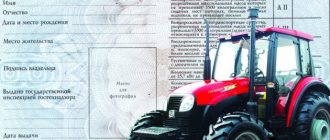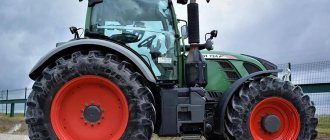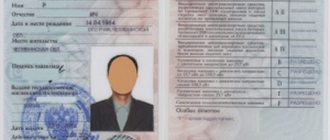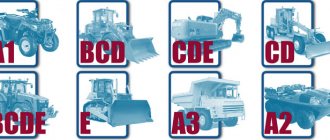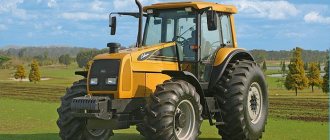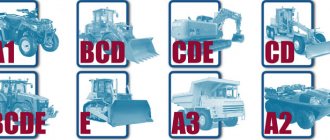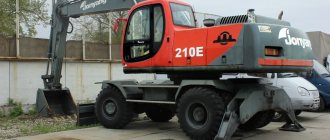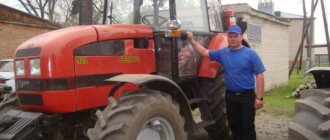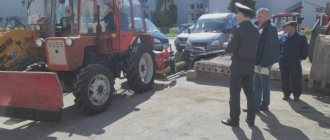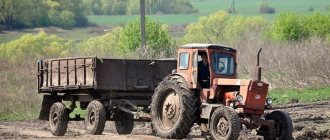Tractors and other agricultural vehicles have some features that are dictated by operating conditions. To drive such vehicles, you must obtain permission from the state technical inspection. What categories and subcategories of tractor rights are established in Russia and by what regulatory act are they regulated? What vehicles can be driven in each category and subcategory? What does the “special notes” column mean and what entries are made there? We will answer these and other questions in this article.
The rights of a tractor driver now: current changes
In addition to the abolition of temporary permits, the very concept of “independent study” has also been abolished. That is, for a long time it was possible, without attending a course at Gotekhnadzor, to simply pass theory and driving exams and receive a tractor license. Now - no, a mandatory condition for admission to the exam is the presence of a certificate of completion of a training course at Gostekhnadzor.
The current model of tractor driver's license was introduced in 2011. This is a laminated cardboard or plastic card with the owner's information and photograph printed on it. Cardboard or plastic – at the discretion of the recipient, the plastic option is more expensive.
Now, in addition to the individual number, the ID is also equipped with a unique barcode. According to the creators of the new sample document, this will relieve the inspector from the need to enter the machine operator’s data into his gadget to obtain additional information about him (presence of unpaid fines, etc.). I read the barcode, like in a supermarket, and the operator’s full history is displayed on the screen. Of course, tractor rights were not the same in the past.
New sample certificate
license is a laminated document containing information about the driver. The main side contains personal data (full name, date of birth, where the person lives), who issued the document and until what time the document is valid. The identification code and photograph of the driver must be present. The reverse side is reserved for categories and marks. The document is certified by the signature of the Gostekhnadzor inspector and seal.
How to check for authenticity
Recently, you can check the a tractor driver’s It is enough to send a request on the website by entering the document data (ID code, when issued and the owner’s full name). If it was obtained legally, it will be displayed in the database. However, the service does not work in all regions, so it is better to check the authenticity with Gostekhnadzor.
Some signs will help you identify a fake right away. The fake may differ in color (have a bright blue or burgundy tint), font, and type of printing. If the data is printed unevenly, blurred or even handwritten, the photo is pasted unevenly, the text is hard to read, most likely it is a fake license.
About the history of tractor rights
Everyone knows that during the Great Patriotic War, 14 and even 12 year old boys worked on tractors. However, the rights to these agricultural machines already existed: they were introduced back in 1933 by the People's Commissariat of Agriculture.
Start
This was due to the rapid growth of mechanical engineering and agriculture in our country. Industrial giants built from scratch - the Stalingrad, Kharkov, and Chelyabinsk tractor plants - began to produce their first products.
These new tractors were significantly different from the primitive technology used before. They required a certain amount of knowledge and skills, and skillful handling. The widespread distribution of MTS (machine and tractor stations) began - to ensure a high level of maintenance of agricultural machinery and maximum mechanization of labor on collective and state farms.
According to the resolution of the Council of Labor and Defense of the USSR No. 827 dated September 21, 1933, in order to be allowed to drive a tractor, every current or future machine operator must pass a qualification commission and receive a tractor driver certificate “classifying all tractor drivers according to their level of knowledge as 1st or 2nd category."
For those who were able to obtain category 1 certificates, when calculating all prices, the coefficient increased by 0.1 workdays. Simultaneously with receiving a tractor driver’s license, the machine operator signed an obligation to work for at least two subsequent years in the MTS or in the collective farm (state farm) that sent him to the qualification commission.
Tractor rights in Brezhnev times
Later (starting from the 60s), any graduate of a rural school could receive a tractor driver’s license. In rural areas, the subject “mechanical engineering” was introduced in schools. As part of this course, once a week lessons were held for boys to study the design of wheeled tractors such as “MTZ-80”, “T-40”; tracked "DT-75"; and SK-5 Niva combines. For girls, during this lesson, most schools held a completely different lesson - an elective in needlework.
Practical lessons on driving the above-mentioned tractors were periodically organized outside of school hours. The equipment was provided by the local collective farm. Or - many rural schools had their own experimental farms, and they each had their own wheeled and caterpillar tractors.
Shortly before the end of the last school year, a representative of the regional Gostekhnadzor came to the 10th grade students and their mechanical engineering mentor and took the children’s theory and practice exams. At the same time, in order not to “move back and forth” several times, he brought with him already printed and ready-made 2nd class tractor driver’s licenses for each of the students (the teacher collected photos and personal data for all of them and took them to the district in advance).
Exams and driving were accepted very loyally: it was enough to show the most minimal knowledge and skills in order to become the owner of a tractor driver’s license - a book with “Kirovets” on the cover (this was in the 80s, earlier it depicted a much more “modest” tractor - "DT-20"). In the most egregious cases of a candidate’s complete unpreparedness (which, in principle, never happened), the inspector did not give him a booklet, but took it with him. And to get a license you had to go to the regional center and retake the exam there.
City residents could, if they wished, take a course at a vocational school and pass a tractor license on their own. They could also be obtained while serving in student construction brigades, or during service in the Soviet Army.
“Allowed” stamps after passing the mechanical engineering exams were placed in the columns of three categories: “A” – wheeled tractors up to 1.4 traction class (“MTZ-80”); “V” – tracked tractors (“DT-75”) and “G” – self-propelled machines with mechanical transmission (Niva combines, etc.) Other categories of Soviet tractor licenses, for which you had to study and pass exams separately: “B” – Wheeled tractors with a class of over 14 kN (1.4 tf); “D” – self-propelled vehicles with hydrostatic transmission; “E” – reclamation, road-building machines, excavators with a bucket with a capacity of up to 0.65 cubic meters.
Currently, the list of categories of tractor rights has expanded significantly. This is due to the emergence of new types of equipment, as well as the synchronization of Russian tractor driver licenses and their foreign analogues.
Brief summary
What rights are needed for MTZ 80 and 82? – Tractor driver’s license with an open license category “C”.
What is the category of rights for MTZ with an excavator bucket? – UTM with an open category “C”, as well as a mark on obtaining qualifications as an excavator driver.
What is the category of rights to MTZ with kun? – UTM with open category “C” and o.
What licenses are needed for a MTZ with a trailer? – UTM with open category “C”.
Modern categories and subcategories of the tractor driver's license
Currently, there are 6 categories plus 4 subcategories that clearly separate tractor licenses by type of equipment.
- A – for motor vehicles that are not intended for driving on public roads and/or have a design speed of no more than 50 km/h.
With subcategories:
I – for off-road motor vehicles;
II – for off-road vehicles whose maximum weight is within 3.5 tons, and the number of seats is no more than 8 (except for the driver’s seat);
III - for off-road vehicles with a maximum weight of over 3.5 tons, but except for those specified in the IV subcategory;
IV – for off-road vehicles that are intended to transport passengers and have more than 8 seats (except for the driver).
- B – for wheeled and tracked tractors with a motor power of up to 25.7 kW;
- C – only for wheeled vehicles, with engines in the power range from 25.7 to 110.3 kW;
- D – only for wheeled vehicles, with a motor over 110.3 kW of power;
- E – for all tracked tractors whose engine power exceeds 25.7 kW;
- F – for combines and other self-propelled agricultural machines.
Do I need a license to drive a mini tractor, a walk-behind tractor with a cart, or an ATV?
Okay, the upper limits of power are clear, but what are the minimum limits today? At what threshold does mini-farm equipment begin to be considered a tractor or a self-propelled machine that requires a license to operate?
According to the new regulation, a tractor driver's license must be obtained to drive any trackless vehicle, the design of which provides for an independent drive and an internal combustion engine with a volume exceeding 50 cubic centimeters. Or - an electric motor with a power of over 4 kW. The maximum speed limit is 50 km/h. If it’s more, then you will no longer need a tractor license, but a car license.
Thus, to operate not only the majority of mini-tractors, but even the corresponding power walk-behind tractor with a trolley, a tractor driver's license is required.
Of course, small agricultural machinery works on personal plots, vegetable gardens and small fields. And it appears on public roads extremely rarely and only briefly, or does not appear at all. Therefore, no one issues tractor driver’s licenses for this equipment, and no one registers it with Gostekhnadzor either.
The likelihood of getting fined is negligible. But such curious cases still exist: the owners of mini tractors or walk-behind tractors with carts talk about them very picturesquely.
For example: in the evening I went to my neighbor’s house on a walk-behind tractor to pick up a couple of carts of manure, and here on the village road were “stray” traffic cops from the district or region. As a result, the protocol is driving without a license, a fine from 5 to 15 thousand rubles; referral to a commission in order to force them to undergo training and obtain a tractor driver’s license. It is useless to file complaints: the court clearly takes the side of the traffic police.
The same thing - an ATV, a snowmobile, a motor sleigh and a motor sled. All these vehicles belong to category A of the tractor driver’s license.
What kind of technology is this?
This type of vehicle means self-propelled vehicles that have an engine and are used for the following types of work:
- main activity – use in the agricultural industry;
- performance of road construction works;
- industrial use;
- transport functions;
- earthmovers.
This type of vehicle is characterized by low speed and enormous traction force. Basic elements: engine, chassis, transmission, control mechanisms, basic and additional equipment.
Such vehicles are divided into groups based on their type:
- Wheeled. Such tractors can be used on asphalt roads, but on the ground they are less effective - the traction force becomes less, and if we are talking about loose soil, the tractor will generally stall. Four-wheel drive solves the problem. However, this type of tractor greatly compacts the soil in the fields.
- Tracked. The traction force here is much greater, the speed ranges from 5 to 40 km/h. The pressure exerted on the soil is much less due to the tracks, but they cannot drive on asphalt (unless they have rubber tracks). Thanks to these characteristics, crawler tractors are used for agricultural work.
Specific examples of popular tractors and self-propelled machines by category
For clarity, check out the selection of specific vehicles belonging to the relevant categories of tractor licenses.
- A- I : Yamaha ATV, Stealth; snowmobile "Tundra", all-terrain vehicle "Kunitsa", "Ataman".
- A- I I : Snow and swamp-going vehicles “Marsh” (based on the VAZ “Niva”); “Vector 4x4” (on a UAZ chassis).
- A- I I I : Cargo snow and swamp-going vehicles “Mamontenok” (with a cabin from “GAZ-3307”); "Tungus" (from "KAMAZ").
Snow and swamp-going vehicle "Mammoth".
- A- I V : Low-floor apron buses (“MAZ”, “LiAZ”, “Neoplan”, etc.) for transporting passengers from the airport building to the aircraft and vice versa.
- Q: Mini tractors “Rusich”, “Uralets”, etc.; any walk-behind tractor with a trolley and a motor with a power of up to 25.7 kW. Tractor "T-25 Vladimirets". Mini excavator "JCB 8026CTS". Warehouse electric forklifts.
- C: Tractors “MTZ-80/82”, “T-40”, “Agromash-85”; excavators "EO-2621" ("Petushok"), "JCB 3СХ". Diesel warehouse forklifts.
Tractor "Agromash-85".
- D : Tractors “Kirovets K-744”, “MTZ-3522”, “KAMAZ XTX-215”.
- E: Tractors and bulldozers “DT-75”, “VT-150”, “MTZ-1502”, “MTZ-2103”. Snow and swamp-going vehicle "GAZ-3409 "Beaver".
- F : Grain and forage harvesters of all types.
Conditions for issuing tractor licenses
Firstly, to obtain a tractor driver’s license you must reach the legal age, and for three subcategories you must also have a certain length of experience. Namely:
- At the age of 16 years you can only obtain a tractor license of subcategory A I.
- At the age of 17 years you can obtain a tractor license of categories AI, B, C, E, F.
- over the age of 18 you can open the same categories plus another category
- at the age of 19 years, you can open all the categories mentioned above, plus additional subcategories A II (but if you already have experience in the automobile category B of 12 months), and A III (but if you already have experience in the automobile category C of 12 months),
- at the age of 22 years, with at least 12 months of experience in automobile category D, you can open all categories of tractor licenses, including the last subcategory A IV.
Practical lesson on learning to drive a tractor.
To obtain admission to the driving license exams at Gostekhnadzor, you need to undergo appropriate training in the same state organization, receiving a certificate of completion of these courses. And also undergo a medical examination and receive a medical certificate confirming the absence of contraindications for driving tractors and self-propelled machines.
The exam, like a car license, consists of theoretical (answering questions) and practical (driving) parts. A tractor license, like a car license, is issued for a period of 10 years. Outdated tractor driver's licenses from the USSR can be replaced with a new document without passing an exam. But for this you need to get a medical certificate and pay a state fee too.
Do you need a license for a mini-tractor?
Mini tractors are mainly popular among farmers, as this type of special equipment is excellent for performing land work. Some potential buyers of such units often have questions about the availability of the necessary documentation and rights. In any case, such equipment must be registered with the State Technical Supervision for registration. This organization also issues permission to use this unit.
It is impossible to give a definite answer about the need to obtain rights. However, there are cases when obtaining this document is mandatory:
- The equipment will be used during construction work.
- The mini-tractor will perform tasks in production or public utilities.
- The unit is used for processing farm land.
- He is a road user.
Simply put, if the owner uses this type of transport within the city and drives onto the roadway, then registration of a license is mandatory. Documents are not required if the tractor is used only within a private farm - for plowing a garden. However, registration of equipment is necessary so that special equipment receives a special number in the register, which will enable the owner to freely use the tractor.
Important! In addition to registration with Gostekhnadzor, the mini-tractor must undergo a full technical inspection. This point is important for equipment that operates within the city or is classified as agricultural.
